Technologies
PSVR 2 vs. Quest 2: Which Should You Buy, or Should You Wait?
Two very different VR headsets compared — and you may also want to wait for the inevitable Quest 3.
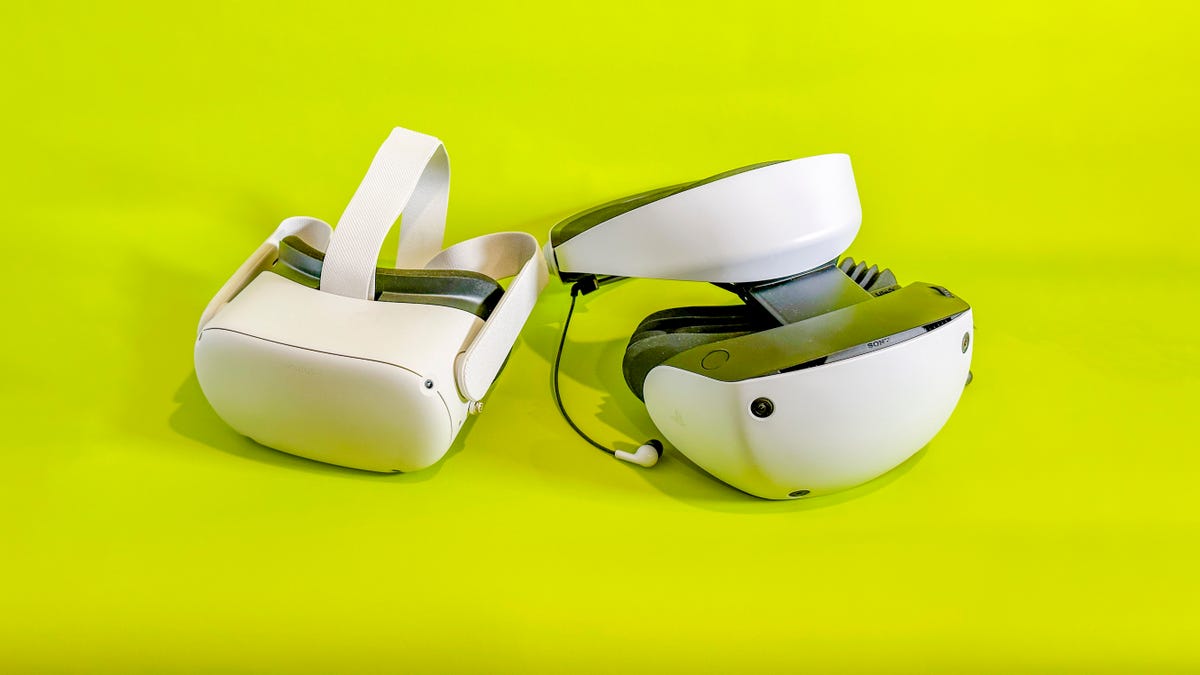
Sony’s PlayStation VR 2 is the PlayStation 5’s first dedicated VR headset, but 2023 is just getting started. With Meta’s Quest 3 expected by the end of the year and Apple’s unknown VR/AR headset expected to make an appearance as well, this isn’t necessarily the best time to get a VR headset. But we love a lot of what the PSVR 2 offers, even if it’s currently limited to a smaller game library and needs a wired connection to a PS5.
The Quest 2 is the most successful VR headset, although it’s over two years old. Here’s how these two devices differ and what each is best at. My colleague Justin Eastzer and I deeply discussed the topic in the video embedded in this story.
For more, read CNET’s PSVR 2 review and Quest 2 review, and check out our favorite Quest 2 games and PSVR 2 games.
Read more: Best VR Headsets of 2023
Hardware: Standalone vs. cabled
The Quest 2 is a fully self-contained VR game system; nothing else is required. For its $399 (£399, AU$630) price, that’s a huge advantage that other competitors are still trying to match.
The $550 (£530, AU$880) PlayStation VR 2, meanwhile, is tethered to a nearly 15-foot cable that needs to be plugged into a PlayStation 5. It doesn’t work on its own at all. It’s really a headset extension of your PS5.
That difference in design makes a bigger impact than you might think. The Quest 2’s portability also means it’s an easy headset to set up for full-motion VR gaming and fitness games and apps. Games like Beat Saber, and fitness apps like Supernatural, are some of the best things you can do on the headset.
The PSVR 2’s cable is long, and it feels heavy. The one-cable setup and its self-contained in-headset camera-based tracking are a lot easier to set up than the original PSVR was, but it’ll still need to live wherever your PS5 lives, and makes the PSVR 2 a better sit-down or stand-in-place experience than a full-motion one.
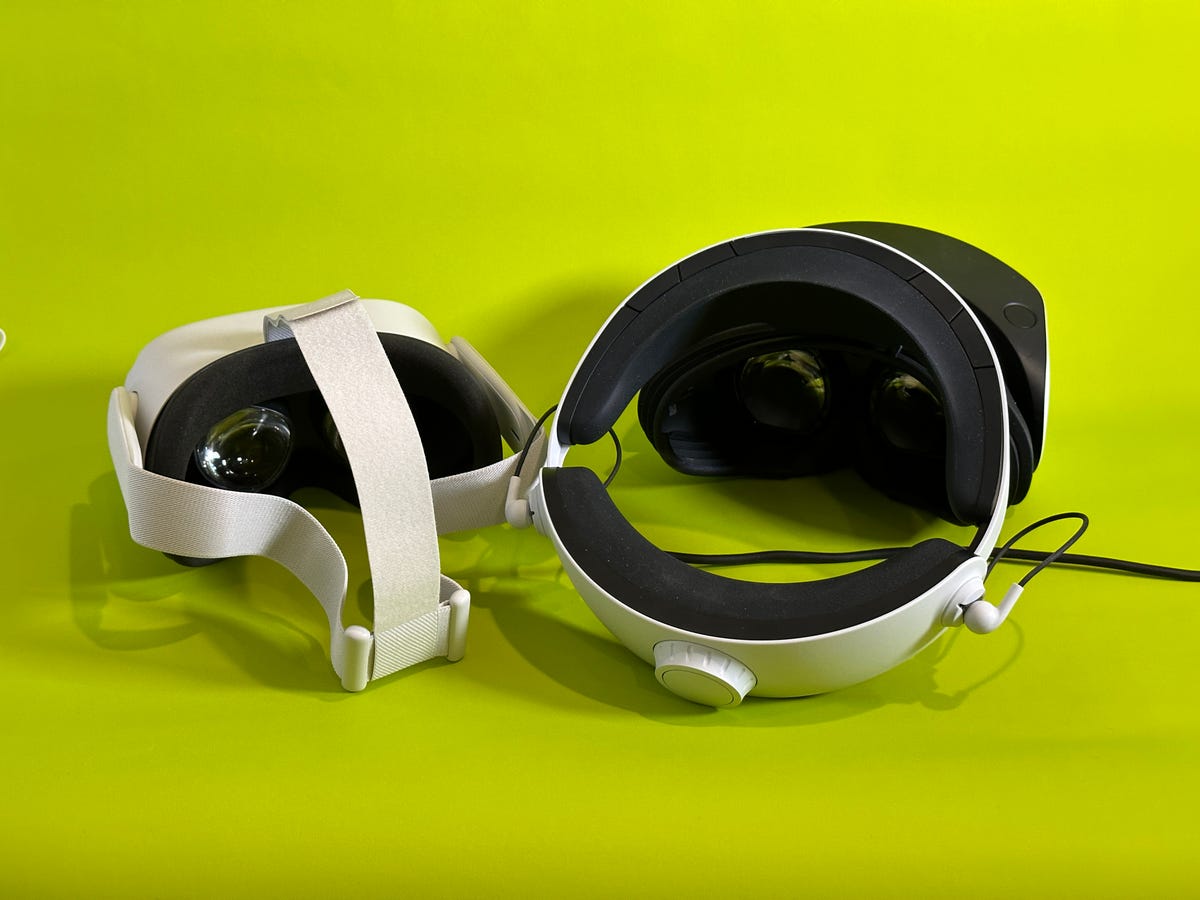
The Quest 2 (left) is more compact, but has less impressive graphics and optics. The PSVR 2 fits my glasses better, is comfier, but it’s bigger.
Scott Stein/CNETDisplays and audio: PSVR 2 has a big edge, mostly
The Quest 2’s LCD-based display is pretty sharp (1,832×1,920 pixels per eye), but the PSVR 2’s 2,000×2,040 pixel-per-eye HDR OLED display is higher res, more vivid and has much better contrast and black levels. Colors are bright and rich. On top of that, the PSVR 2’s ability to drive PS5-quality graphics means games have greater detail than the Quest 2. The latter uses an integrated Snapdragon XR2 mobile processor that’s less powerful, although the Quest 2 can be tethered to a gaming PC, which lets it play higher-end games similarly to the PS5.

The PSVR 2 (right) can adjust its distance from your face, but its visor design is bulkier.
Scott Stein/CNETThe Quest 2 has speakers that pump 3D audio near your ears but still lets other sounds in, which is bad for cinematic experiences but good for hearing kids or alarms — handy when absorbed in VR. It also has a headphone jack. The PSVR 2 has included earbuds for 3D audio but no speakers, which means you’re far more isolated when listening to audio. The earbuds sound OK, but Sony’s wireless Pulse 3D over-ear headphones (sold separately) offer better sound. The PSVR 2 has a headphone jack too, just like the Quest 2.
The PSVR 2 also adds an extra couple of immersive wrinkles. The headset uses eye tracking to boost graphics quality where your eyes are looking via foveated rendering technology. The headset also has rumble, which sounds gimmicky but can feel like an extension of bass vibrations in-game, adding an overlap between sound and immersive sensation.
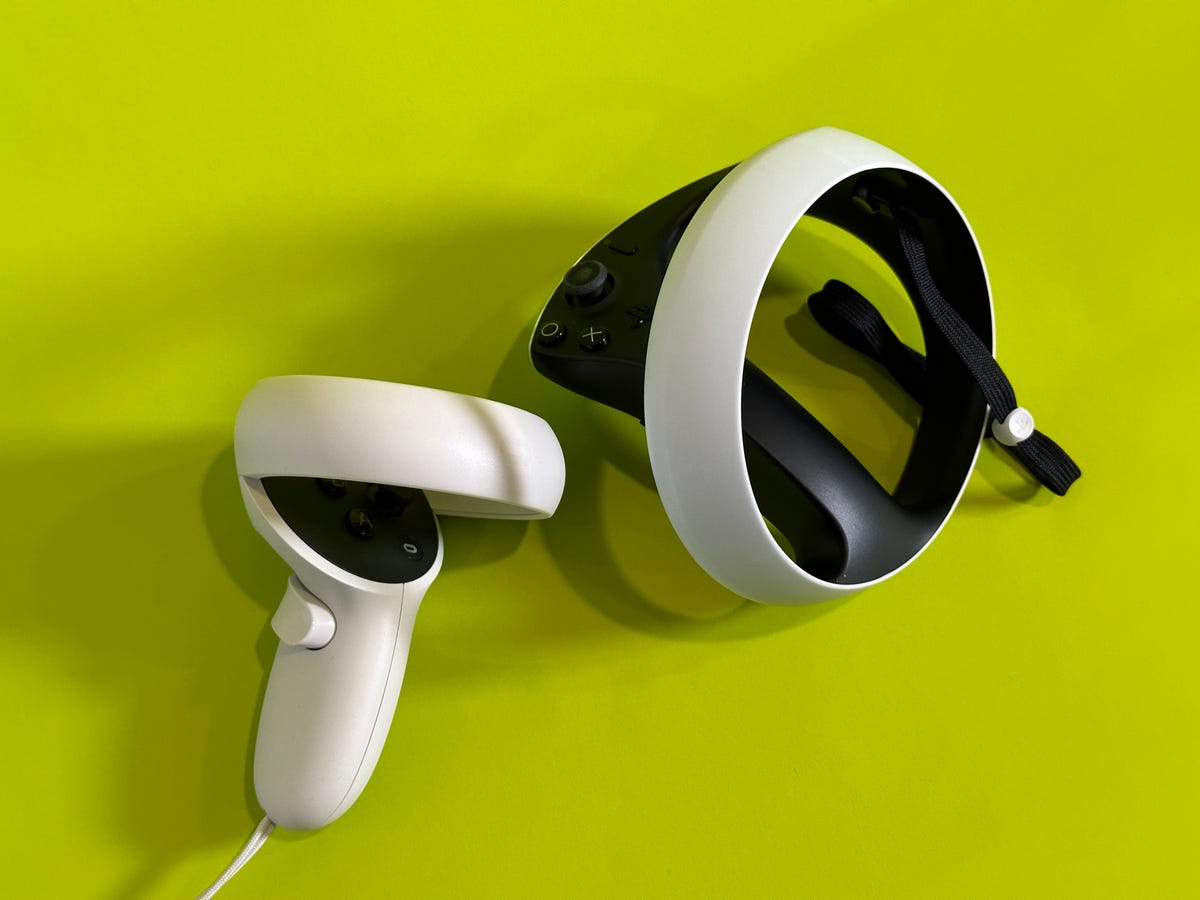
The Quest 2 Touch controller (left) and PSVR 2 Sense controller: Similar button/stick/trigger layout, but the PSVR 2 has better haptics and force feedback, while the Quest 2 has better finger sensing off-button.
Scott Stein/CNETControllers and input: PSVR 2 has better haptics and eye tracking, Quest 2 has hand tracking
The PSVR 2 and Quest 2 have the same type of controller design, mostly: VR headsets have settled on buttons, analog sticks, triggers and grips that are pretty consistent across the board. The PSVR 2 Sense controllers have much better vibration feedback and even force-feedback «adaptive triggers» that offer resistance in some games. These are features the PS5 DualSense controller already has, but they feel a lot richer in VR than the Quest 2’s pretty basic buzzing. The PSVR 2 also uses eye tracking to add additional controls in some games, letting you glance at objects to select them, potentially improving accuracy.
The Quest 2 has better finger awareness when holding the controllers, sensing when your fingers are on or off, or even resting on the buttons or triggers. This awareness can create sensations that feel like hand tracking. The PSVR 2 doesn’t do this nearly as well yet. Also, the Quest 2 can do actual hand tracking without needing any controllers. This input type isn’t perfect, but it can be helpful… and the PSVR 2 doesn’t do this at all (yet).
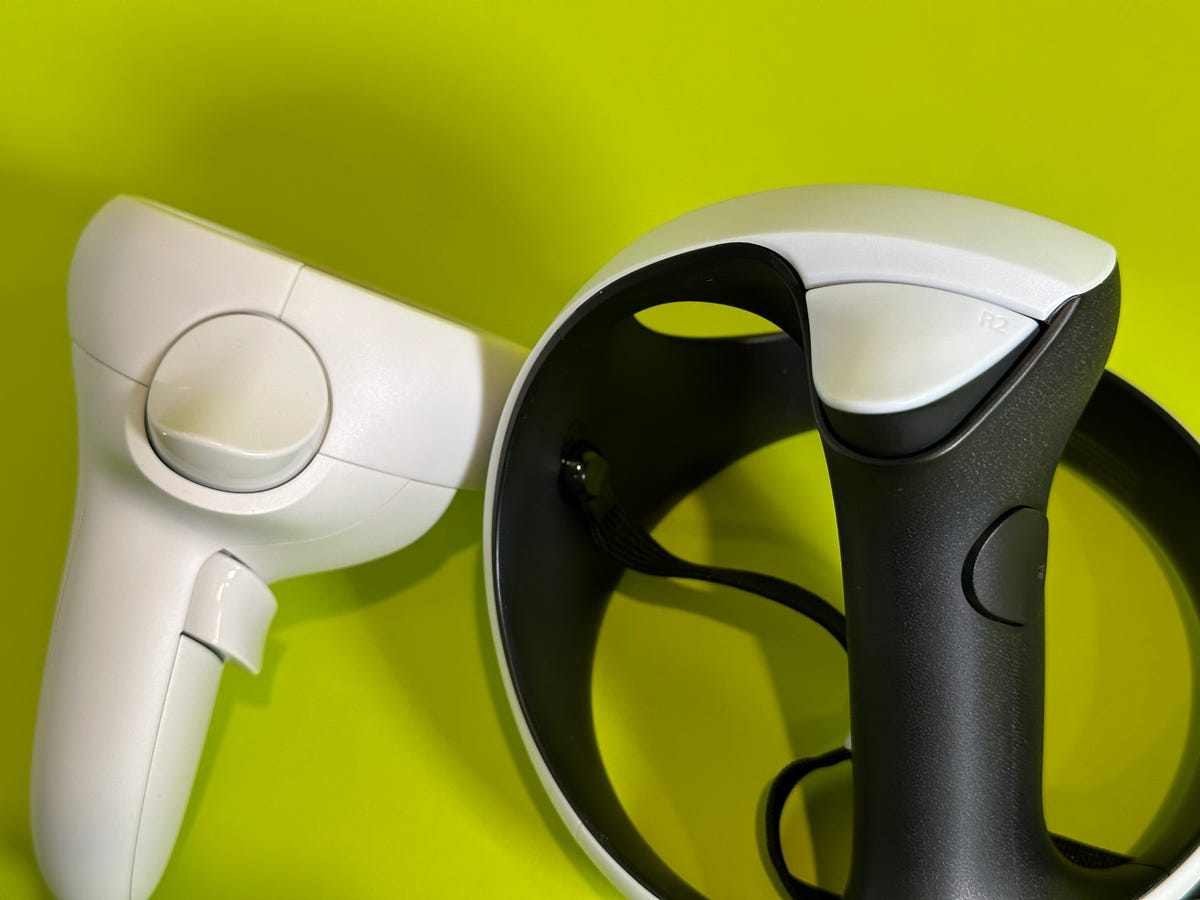
The PSVR 2’s triggers (right) have pressurized force feedback you can feel, which gives an edge for some games.
Scott Stein/CNETSoftware: Quest 2 has a huge advantage (for now), PSVR 2 has some standouts
The Quest 2’s software library covers hundreds of games, productivity and design apps, fitness apps, meditation apps and social world apps. There are also plenty of free apps and games. The Quest platform has been around since 2019, giving it a big lead time. The PSVR 2 is starting from scratch. The hardware isn’t automatically backward-compatible with original PSVR games. Although many of those games are getting PSVR 2 upgrades, it means waiting for the updates to happen, if they do at all.
For now, the PSVR 2 is also skipping entire genres found on the Quest 2. The PSVR 2 is all games, as you’d expect. There should be a few fitness apps (Les Mills Body Combat is already available) but no social world apps. That might be comforting for parents with younger kids, but it leaves out extra uses you could get from the still-evolving Quest 2.
Additionally, most of the PSVR 2 launch games are ports of games on the Quest 2. Only a few are unique standouts that the Quest 2 natively lacks: notably Horizon Call of the Mountain, Gran Turismo 7, Resident Evil Village and No Man’s Sky, with more coming.
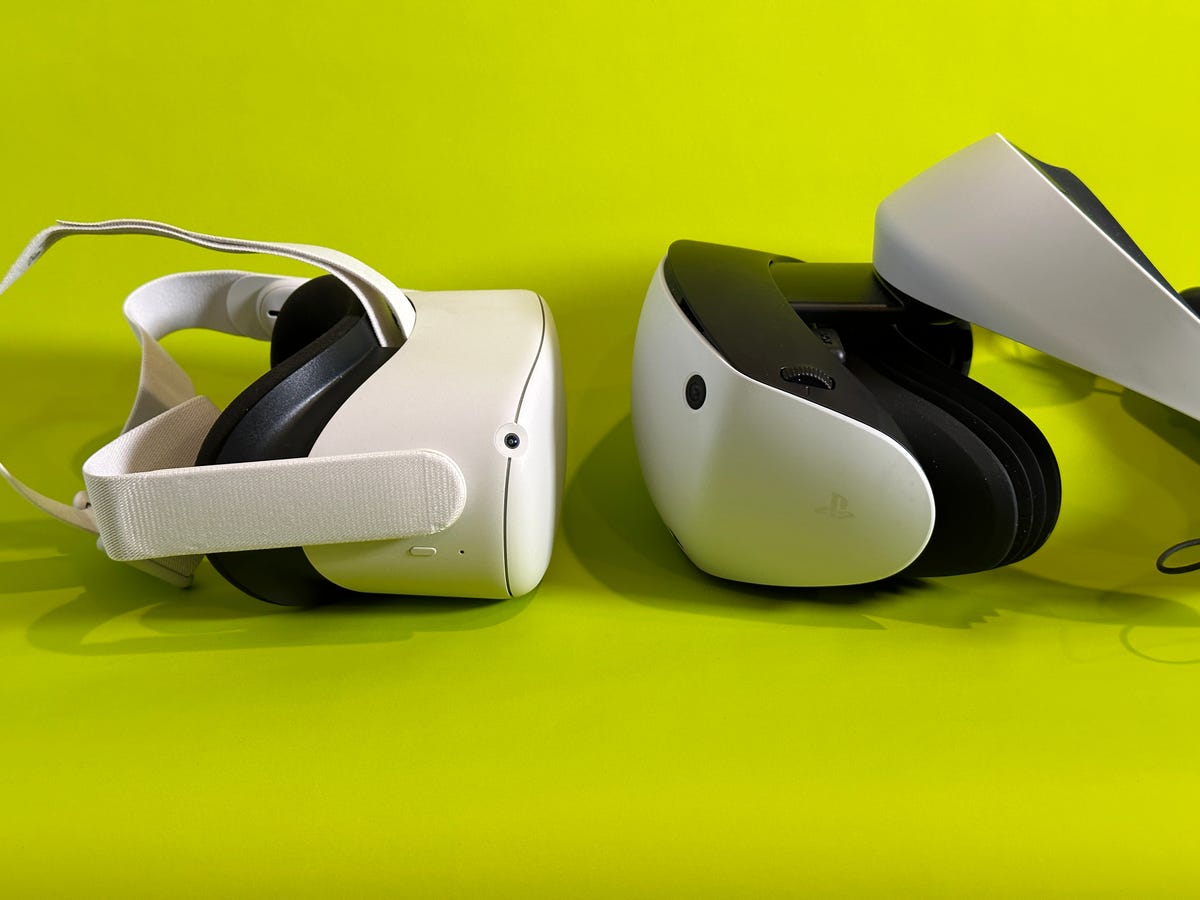
The PSVR 2 (right) has eye tracking and more adjustable eye distance, or IPD, while the Quest 2 lacks eye tracking and has only three IPD settings.
Scott Stein/CNETPrice: Quest 2 has the edge
The $399 all-in value of the Quest 2 is a big advantage here. The PSVR 2 is more expensive at $550, and you still need the PS5, making it a $1,000-plus investment. But the Quest 2 is getting old, and a Quest 3 will likely come later this year that you should hold off for.

Yes, you should wait
Now is the time to wait and see what comes for VR. The Quest 3, expected by the end of the year, should be a clear upgrade over the nearly three-year-old Quest 2, and there’s a chance that many more games (and even a holiday bundle) will upgrade the PSVR 2 experience by year’s end. If you can, I’d hang on and see what the situation looks like for both Meta and Sony in the fall.
If you already have a Quest 2, the PSVR 2 doesn’t offer enough yet to make the switch. And if you’re a PS5 owner who doesn’t mind spending a bunch of money on new tech, the PSVR 2 is already a fun experience, just one we can’t quite get a future sense of yet.
Technologies
The Most Exciting Video Game Rumors and Leaks Ahead of 2026
Technologies
Today’s NYT Mini Crossword Answers for Wednesday, Dec. 17
Here are the answers for The New York Times Mini Crossword for Dec. 17.

Looking for the most recent Mini Crossword answer? Click here for today’s Mini Crossword hints, as well as our daily answers and hints for The New York Times Wordle, Strands, Connections and Connections: Sports Edition puzzles.
Need some help with today’s Mini Crossword? Read on. And if you could use some hints and guidance for daily solving, check out our Mini Crossword tips.
If you’re looking for today’s Wordle, Connections, Connections: Sports Edition and Strands answers, you can visit CNET’s NYT puzzle hints page.
Read more: Tips and Tricks for Solving The New York Times Mini Crossword
Let’s get to those Mini Crossword clues and answers.
Mini across clues and answers
1A clue: Nod (off)
Answer: DOZE
5A clue: Naval submarine in W.W. II
Answer: UBOAT
7A clue: Tricky thing to do on a busy highway
Answer: MERGE
8A clue: Heat-resistant glassware for cooking
Answer: PYREX
9A clue: Put into groups
Answer: SORT
Mini down clues and answers
1D clue: Break up with
Answer: DUMP
2D clue: Falls in line, so to speak
Answer: OBEYS
3D clue: Legendary vigilante who cuts a «Z» with his sword
Answer: ZORRO
4D clue: Rarin’ to go
Answer: EAGER
6D clue: Common reminder for an upcoming appointment
Answer: TEXT
Don’t miss any of our unbiased tech content and lab-based reviews. Add CNET as a preferred Google source.
Technologies
You Can Watch an Exclusive Avatar: Fire and Ash Scene on TikTok Right Now
Disney and TikTok partner on an immersive content hub for James Cameron’s latest movie about the alien Na’vi.
If you’re not quite ready to head to the theater to watch Avatar: Fire and Ash, an exclusive scene preview might sell you on the visual spectacle. As part of a new collaboration with the social media giant, Disney is posting snippets of its new movie to its TikTok account.
This scene isn’t part of any trailer and won’t be posted to other social media accounts, making TikTok the only place you can view it — unless you buy a movie ticket. A first look at the new movie’s scenes isn’t the only Avatar-related bonus on the social media platform right now, either. TikTok has partnered with the house of mouse to bring an entire «immersive content hub» to the app.
A special section of TikTok includes quizzes and educational videos that explore the alien world of Pandora shown off in the movies. On TikTok, you can take a personality quiz to find out what Na’vi clan you most closely align with and unlock a special profile picture border to use on your account.
Science and fiction blend together with a series of videos from real doctors who explain the basis for some of Avatar’s world-building. If you want to learn about exoplanets or how realistic the anatomy of the movie’s alien animals is, these videos will feed your brain while still providing entertainment value.
Perhaps the most enticing part of Disney’s latest social media collaboration is the opportunity for fans to win prizes and trips. TikTok creators who make edits with the #TikTokAvatarContest hashtag are entered into a competition to win Avatar merchandise. The biggest winners will be able to take a trip to visual effects studio Wētā Workshop in New Zealand or visit Avatar director James Cameron’s Lightstorm Entertainment Studio in Los Angeles.
Avatar: Fire and Ash is the third installment in director Cameron’s cinematic passion project. While the first Avatar movie was released in 2009, Cameron didn’t release another entry in the franchise until 2022. In total, there is a five-movie arc planned for the indigo alien Na’vi on the moon of Pandora.
The Avatar movies are known for pushing the boundaries of CGI visual effects in cinema. They are also historically big winners at the box office: the original Avatar is the highest-grossing film of all time, earning $2.9 billion across its theatrical releases. Its sequel, Avatar: The Way of Water, is the third-highest-grossing film of all time, trailing Avengers: Endgame. You can stream those movies on Disney Plus.
It remains to be seen whether Avatar: Fire and Ash will financially live up to its predecessors. The film currently has mixed reviews from critics on Rotten Tomatoes.
-

 Technologies3 года ago
Technologies3 года agoTech Companies Need to Be Held Accountable for Security, Experts Say
-

 Technologies3 года ago
Technologies3 года agoBest Handheld Game Console in 2023
-

 Technologies3 года ago
Technologies3 года agoTighten Up Your VR Game With the Best Head Straps for Quest 2
-

 Technologies4 года ago
Technologies4 года agoBlack Friday 2021: The best deals on TVs, headphones, kitchenware, and more
-

 Technologies4 года ago
Technologies4 года agoVerum, Wickr and Threema: next generation secured messengers
-

 Technologies4 года ago
Technologies4 года agoGoogle to require vaccinations as Silicon Valley rethinks return-to-office policies
-

 Technologies4 года ago
Technologies4 года agoOlivia Harlan Dekker for Verum Messenger
-

 Technologies4 года ago
Technologies4 года agoiPhone 13 event: How to watch Apple’s big announcement tomorrow


